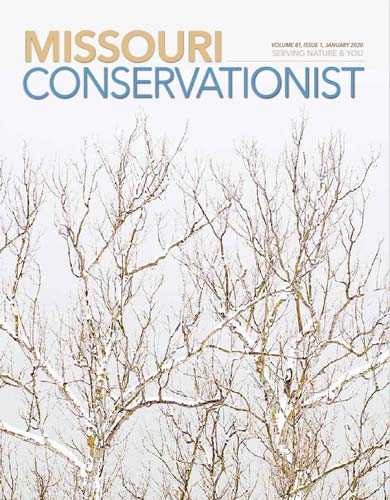Each month, we highlight research MDC uses to improve fish, forest, and wildlife management.
Quail Management
Winter Survival Study
What kind of management and resulting cover help bobwhite quail evade hungry predators and survive winter’s bitter weather?
Research partners, including University of Missouri graduate research assistant Alisha Mosloff, University of Missouri Assistant Professor Mitch Weegman, MDC Resource Scientist Tom Thompson, and U. S. Forest Service Research Wildlife Biologist Frank Thompson, are working to answer this and other questions about quail survival throughout the year.
Thompson said that looking at only one specific period has limited research in the past. “Getting that full life-cycle picture of how quail populations are doing throughout the whole year will really help,” he said.
Mosloff and partners focused their winter study on intensive versus extensive landscapes in southwest Missouri. “Intensive is more the traditional type of management,” Mosloff said. “For example, working on smaller blocks of less than 40 acres interspersed with small food plots, grass strips, and cover habitat.”
Extensive describes large tracts of native grasslands and prairies interspersed with shrubs and managed with periodic grazing and fire.
“We’re looking to contrast these two management practices to see which might lead to higher survival during the winter,” Mosloff said.
She and the research crew collared and radiotracked quail on the same five sites, three extensive and two intensive, in 2017 and 2018. The crew also collected data on the kinds and amounts of vegetation on each of the study sites in 2018.
In addition to comparing the effects of traditional versus prairie-management practices on quail winter survival, the partners can also compare winter versus summer survival. “These two studies have been conducted in tandem,” Weegman said.
“We’re finally getting into what quail need throughout the full year,” Mosloff added.
Quail Winter Survival at a Glance
Methods
Researchers captured adult and hatch-year quail using funnel traps during October 2017 and 2018 on three traditionally managed conservation areas and two prairie dominated conservation areas
- 2017: Caught 136, Radio-tagged 101
- 2018: Caught 158, Radio-tagged 119
- Tracked tagged birds three times per week, Nov. 1–Jan. 31
- Collected vegetative data in 2018
Preliminary Results
- Adults have higher survival (82%) than hatch-year birds (67%)
- Survival is higher on landscapes that have heavy woody components
- Native grass improves survival if there is enough shrubby cover
- Prescribed burning within the last 2 years decreases survival
Research Partners
- Missouri Department of Conservation
- University of Missouri College of Agriculture, Food & Natural Resources
- U.S. Forest Service
Also In This Issue

This Issue's Staff
Editor - Angie Daly Morfeld
Associate Editor - Larry Archer
Staff Writer - Bonnie Chasteen
Staff Writer - Heather Feeler
Staff Writer - Kristie Hilgedick
Staff Writer - Joe Jerek
Art Director - Cliff White
Designer - Les Fortenberry
Designer - Marci Porter
Photographer - Noppadol Paothong
Photographer - David Stonner
Circulation - Laura Scheuler






















